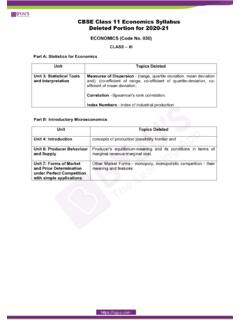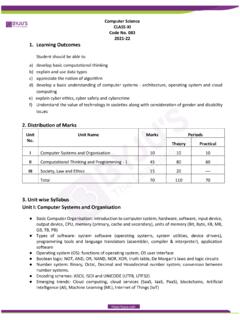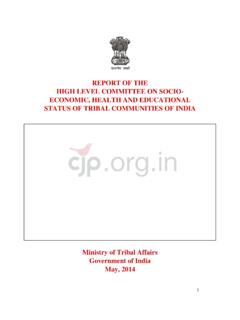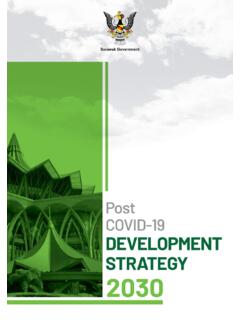Transcription of SMALL BUSINESS AND ENTREPRENEURSHIP
1 CHAPTER 9 SMALL BUSINESS AND ENTREPRENEURSHIPLEARNING OBJECTIVESA fter studying this chapter, you should be able to: explain the meaning and nature of SMALL BUSINESS ; appreciate the role of SMALL BUSINESS in India; analyse the problems of SMALL BUSINESS ; and classify the different forms of assistance provided by thegovernment to SMALL BUSINESS , particularly in rural and hilly scale industries contributesignificantly to the developmentprocess and acts as a vital link in theindustrialisation in terms ofproduction, employment and exportsfor economic prosperity by wideningentrepreneurial base and use of localraw materials and indigenous scale industries dominate theindustrial scenario in the country withsizeable proportion of labour force andtremendous export India, the 'village and smallindustries sector' consists of both'traditional' and 'modern' smallindustries.
2 This sector has eightsubgroups. They are handlooms,handicrafts, coir, sericulture, khadiRomi Bags of ManipurKhumbongmayum Dhanachandra Singh didn't have much in life. The son of apoor tailor, he wasn't brought up with many privileges. He saw his father workingday and night to earn a meager income. He saw the rich getting richer and thepoor remaining poor. The boy wanted to do something more in life. He couldn'timagine a life of stitching clothes relentlessly and earn just enough to is a SMALL city. Hardworking men and women send their children awayto bigger cities so they can have opportunities to progress. Khumbongmayum'sfather couldn't afford to send him or even educate him. He just taught him whathe knew- tailoring. Fabrics, stitching and clothing styles was what the boy grewup with.
3 There was only one sewing machine and the boy used it when hisfather wasn't using it. He learnt it silently because he knew it was what hisfather wanted but his heart wasn't in an incisdenr can change your life. This happened toKhumbongmayum when he stitched a purse made out of leftover fabrics fromhis father's scraps. Khumbongmayum offered the purse to his friend whomarveled at the unique design. The friend in turn showed the interesting purseto his other friends. They asked Khumbongmayum if he could make such pursesfor them. It led him to wonder if there was a market for his designs. And heknew he had stumbled on to his BUSINESS venture. He made a BUSINESS planand launched a purse making company 'Romi Bags' in 1996. Khumbongmayumwas not one to do anything on a whim.
4 He noticed the demands of his productand he calculated his costs, expenses and expected income. He ignored thedetractors and critics. As a first time entrepreneur, he believed in whateverquality of materials he was getting. This was his biggest mistake. The cheapquality of materials for shoes led to them being rejected by the was returning and remaining unsold in the factory. Khumbongmayumlearnt his first lesson. In 2007, he received the National Award for in Bag Makingfor Micro & Medium Enterprises. For him though, it's just the Dhanchandra Singh has changed his life by sheer grit,perseverance and hard work. You can't let anything stop you from movingforward. You can't become successful or reach the top in a day. ew if you listenand hear BUSINESS AND ENTREPRENEURSHIPand village industries, SMALL scaleindustries and powerlooms.
5 The lasttwo come under the modern smallindustries, while the others come undertraditional industries. Village and smallindustries together provide the largestemployment opportunities in OF SMALL BUSINESSIt is important to know how size isdefined in our country, with referenceto SMALL industries and SMALL businessestablishments. Several parameters canbe used to measure the size of businessunits. These include the number ofpersons employed in BUSINESS , capitalinvested in BUSINESS , volume of outputor value of output of BUSINESS andpower consumed for businessactivities. However, there is noparameter which is without on the need, the measurescan definition used by theGovernment of India to describe smallindustries is based on the investmentin plant and machinery. This measureseeks to keep in view the socio - economic environment in India wherecapital is scarce and labour is emergence of a large servicessector has necessitated the governmentto include other enterprises coveringboth SMALL Scale Industries (SSI) sectorand related service entities under thesame umbrella.
6 Expansion of the smallscale enterprises was taking placegrowing into medium scale enterprisesand they were required to adopt higherlevels of technologies in order to remaincompetitive in a fast globalizing , it was necessary to address theconcerns of such enterprises micro, SMALL and medium and provide themwith a single legal framework. TheMicro, SMALL and Medium EnterprisesDevelopment (MSMED) Act, 2006addresses these issues relating todefinition, credit, marketing andtechnology up gradation. Medium scaleenterprises and service relatedenterprises also come under thepurview of this Act. The MSMED Act,2006 came into force , October, , enterprises areclassified into two major categories viz.,manufacturing and the case of enterprises engaged inthe manufacture or production ofgoods pertaining to any industriesspecified in the first schedule to theIndustries ( development andRegulation) Act, 1951, there are threetypes of enterprises:(i)Micro enterprise: where theinvestment in plant and machinery doesnot exceed twenty- five lakh rupees.
7 (ii) SMALL enterprise: where theinvestment in plant and machinery ismore than twenty five lakh rupees butdoes not exceed five crore rupees.(iii) Medium enterprise: where theinvestment in plant and machinery ismore then five crore rupees but doesnot exceed ten crores the case of enterprises engaged inproviding or rendering of services thereare three types of enterprises:(i) Micro enterprise: where theinvestment in equipment does notexceed ten lakh rupees.(ii) SMALL enterprise: where theinvestment in equipment is more thanten lakh rupees but does not exceedtwo crore rupees.(iii) Medium enterprise: where theinvestment in equipment is more thantwo crore rupees but does not exceedfive crore IndustriesVillage industry has been defined asany industry located in a rural areawhich produces any goods, renders anyservice with or without the use of powerand in which the fixed capitalinvestment per head or artisan orworker is specified by the centralgovernment, from time to IndustriesCottage industries are also known asRural Industries or TraditionalIndustries.
8 They are not defined bycapital investment criteria as in the caseof other SMALL scale , cottage industries arecharacterized by certain features likethe following: these are organised by individuals,with private resources; normally use family labour andlocally available talent; the equipment used is simple; capital investment is SMALL ; produce simple products, normallyin their own premises; production of goods usingindigenous OF SMALL BUSINESS IN INDIAS mall Scale Industries in India enjoy adistinct position in view of theircontribution to the socio -economicdevelopment of the country. Thefollowing points highlight theircontribution.(i) The contribution of smallindustries to the balanced regionaldevelopment of our country isnoteworthy. SMALL industries in Indiaaccount for 95 per cent of the industrialunits in the country.
9 (ii) SMALL industries are the secondlargest employers of human resources,after agriculture. They generate morenumber of employment opportunitiesper unit of capital invested comparedto large industries. They are, therefore,considered to be more labour intensiveand less capital intensive. This is aboon for a labour surplus country likeIndia.(iii) SMALL industries in our countrysupply an enormous variety ofproducts which include massconsumption goods, readymadegarments, hosiery goods, stationeryitems, soaps and detergents, domesticutensils, leather, plastic and rubbergoods, processed foods and vegetables,2019-20215 SMALL BUSINESS AND ENTREPRENEURSHIP wood and steel furniture, paints,varnishes, safety matches, etc. Amongthe sophisticated items manufacturedare electric and electronic goods liketelevisions, calculators, electro-medicalequipment, electronic teaching aids likeoverhead projectors, air conditioningequipment, drugs andpharmaceuticals, agricultural toolsand equipment and several otherengineering products.
10 A specialmention should be made ofhandlooms, handicrafts and otherproducts from traditional villageindustries in view of their export value.(see Box A which highlights the majorindustry groups that come under thepurview of SMALL industries as per theclassification laid down by thegovernment.)(iv) SMALL industries which producesimple products using simpletechnologies and depend on locallyavailable resources both material andlabour can be set up anywhere in thecountry. Since they can be widelyspread without any locationalconstraints, the benefits ofindustrialisation can be reaped byevery region. They, thus, contributesignificantly to the balanceddevelopment of the country.(v) SMALL industries provide ampleopportunity for ENTREPRENEURSHIP . Thelatent skills and talents of people canbe channeled into BUSINESS ideaswhich can be converted into realitywith little capital investment and almostnil formalities to start a SMALL BUSINESS .















